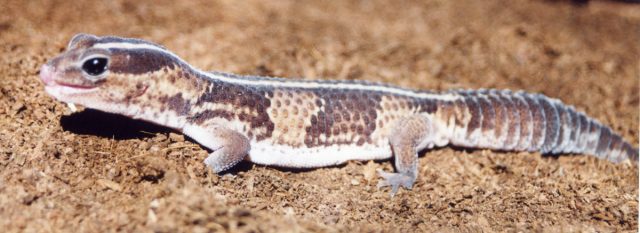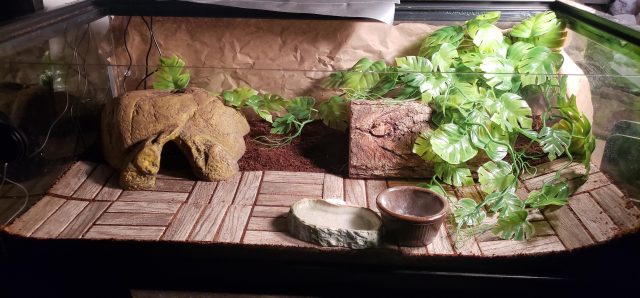African Fat-Tailed Geckos are becoming more popular due to how easy they are to care for. They’re native to West Africa and can be found in savannah habitats, rocky hillsides, river edges, and scrubland. You can expect your gecko to grow up to 7 or 8 inches long.

These geckos can live up to 15 years in captivity, sometimes even 20. Since their environment is dry and arid they spend most of their time in dark and humid hiding places. This includes rock cracks and other similar spots.
You should get ready to take care of a gecko that needs its enclosure to maintain a temperature between 80F and 95F. In this article, we’ll talk about everything you need to know about their cages and how to take care of them.
African Fat Tailed Gecko Cage Setup
African Fat-Tailed Geckos need a pretty hot environment which is why wooden vivariums are the best options for their needs. This is mainly because they are great insulators and they’re capable of maintaining the heat inside the enclosure.
A huge advantage of these geckos is that you don’t have to worry about them escaping all the time. You still need to ensure they can’t open the lid of the tank and walk out but it’s less stressful. They’re much more docile than their Leopard gecko cousins and love spending most of their time laying around and napping.
It’s ideal to have an enclosure that has glass sliding doors and large air vents that can maintain a healthy flow of air for the geckos. These beautiful creatures are nocturnal so you need to find a place to put the cage that’s not your bedroom. Keeping lizards that are vocal at night in your bedroom is not a good idea.
If you plan on keeping more than two African Fat-Tailed Geckos, it’s recommended to get a rack system so they can have all the space they need.
What size tank does a African Fat Tailed gecko need?

African Fat-Tailed Geckos don’t grow too much so you can keep them in the same vivarium you kept them as juveniles. A cage for one of them should be around 15 gallons and over 20-gallons if you’re keeping a pair. If you want to keep three, it’s recommended to use a tank that’s at least 25-gallons.
These geckos are not really made for climbing, which means that the tank should be more wide than tall. This will also allow you to build the habitat with more hiding places as they love spending most of their time hidden away.
No matter how docile the gecko is, if it’s kept in an enclosure that’s extremely small it will become very destructive and start tearing the habitat apart. These geckos don’t need a lot of space but they still need to not feel entrapped.
When choosing a cage, you also need to be sure that it’s big enough to fit all the accessories the gecko will need. This includes the lighting and misting systems. Some can be place outside the habitat while others work best if they’re installed inside. It all depends on the instructions on each product you’ll have to use.
Substrate in the cage
You have two options when it comes to setting up the substrate inside an African Fat-Tailed Gecko’s cage. The first one is to use a substrate that can retain water and is covered by moss. This will keep the entire substrate humid, which will help a lot when the gecko is shedding its skin. But don’t keep it soaked in water as this can cause other problems.
The second option, and most recommended, is to use a substrate with a normal capability to absorb water and place the humid moss inside the hiding places. You’ll need to remember to spray the hiding places with water using a spray bottle. The automatic mister might not make it all the way inside to keep the moss humid.
There are a lot of options on the market, some are easier to clean while others are more natural. Bio-active substrates are getting more and more popular and they’re a very good choice for most vivariums. This is because it offers a much more natural look and it encourages the gecko’s wild instincts as well, making it very interesting to observe.
If you’re ever in an emergency or on a budget, you can use newspapers. They’re great at absorbing waste and you can easily replace it. You will need to keep changing it every day instead of just spot-cleaning it. Another cheap option is paper towels that haven’t been bleached and that don’t have any ink on them.
Heating Requirements For Enclosure
African Fat-Tailed Geckos are cold-blooded creatures and they will have to move around the vivarium to regulate their body temperature. This is why you need to ensure that the gecko has all the options it needs by keeping the enclosure heated only at one end.
Pick a suitable end for the gecko’s basking spot and place a heating mat right underneath that place. Your goal is to keep the temperature between 90F and 95F. You might be confused about this method as this is an unusual way to bask. African Fat-Tailed Geckos are nocturnal so this will be their favorite way to bask. You can use a light to create a true basking spot but they will rarely use it.
On the other hand, you need to maintain the other end of the enclosure a lot cooler. It’s recommended to keep it between 75F and 85F. The best way to ensure the habitat doesn’t get too hot or too cold is by using a thermostat. They’re very reliable and easy to use.
When you’re adding a new lighting bulb to the cage it’s important to take the heat it produces into consideration. You might need to turn the heating mat a little bit lower to avoid overheating.
Humidity Requirements in a Vivarium
You can easily be tricked to think that these geckos need very low humidity levels since their natural environment is always very hot and arid. But you need to keep in mind that they only come out at night and they spend most of their time in their hiding places.
They only hide in spots that are dark and very humid. This means you will have to recreate the same environment in your tank. High humidity levels are very important for these geckos and you should never let them drop under 40%. Low humidity levels can cause serious shedding problems.
The ideal levels of humidity are between 50% and 70%. Anything lower or higher than that can cause problems for the African Fat-Tailed Gecko. You should monitor the levels every single day with the help of a reliable hygrometer.
Water retaining substrates will play a big role in maintaining the enclosure humidity. But if the humidity levels rise too much, you need to open up all the air vents and allow the air circulation to take care of it.
Since this requires spraying the vivarium a few times a day, it might come as very inconvenient for some keepers. This is why automatic misters are the best option as they can be set to work on a schedule.
UVB Lighting
African Fat-Tailed Geckos require between 10 and 12 hours of light each day. And since they don’t bask during the day, you don’t have to worry about providing a UVB light that’s very strong. You only need a bulb that provides less than 2% over a small area. This will ensure that the gecko is getting all the Vitamin D3 it needs.
You only need either a T5 or a T8 and be careful where you’re mounting it. It’s important to be placed on the back of the ceiling and close to the warmer end of the enclosure. But you don’t have to worry too much about it since these creatures are nocturnal. Once you get better at keeping lizards, you can start feeding your gecko Vitamin D3 supplements and get rid of the UVB light.
If you’re not sure about the UVB light bulb then it’s best to not use it. High levels of UVB light can be very harmful to your gecko so it’s best to avoid using it if it’s too much of a hassle. This light is only a must to diurnal geckos (those that are active during the day).
Cage Decorations
African Fat-Tailed Geckos don’t typically need a lot of decorations but you should still keep the gecko busy all night long while it’s roaming around. You’ll need to use a good substrate of orchid bark, cypress mulch, or compressed bedding. Then you can start preparing all of their hiding places.
One hiding space should be placed in the hot area and one in the cold area. It’s also recommended to change the placements of the decorations and hiding spaces to help the gecko work its mind as well. The gecko will appreciate the sudden change in the habitat if it’s done well.
For hiding spots you can literally use anything that is reptile-safe and big enough for the gecko to fit inside, This includes cork rounds, half logs, cork flats, mopani wood, grape wood, bamboo hallows, etc. You’ll also be able to find fake rock caves, boulder caves, and more hiding places on the market.
Since real plants require UVB lighting, you can settle for fake plants. The options are endless as you can get fake desert plants, abutilon vines, fake cactus hiding holes, silk plants, and more. While it’s important to not overdo it with the plants, they can greatly improve the look of the enclosure.
How often do you need to clean a African Fat Tailed Gecko’s cage?
The cage needs to be cleaned every day from waste. You will also need to wash the water bowl and refill it each morning. Other than that, it all depends on what type of substrate you use. If it’s bio-active, you only need to replace it twice a year.
Other types of substrates will have to be changed monthly, weekly, or daily. Newspapers and paper towels need to be changed each day. The rest of the substrates last longer. When you need to make the change, it’s best to have a place where you can house the African Fat-Tailed Gecko while you’re cleaning.
It’s important to perform deep cleaning at least twice a year. This includes picking apart the entire enclosure, throw the substrate away, and disinfect the rest. You’ll have to use reptile-safe disinfectant and make sure you’ll rinse the cage properly.
If you notice any bacterial growth then it’s time to throw the substrate away again and start disinfecting. The bathtub you used to wash everything in needs to be disinfected as well. If you can wash it in the garden it’s even better. But only if you don’t grow anything in there.
Conclusion
African Fat-Tailed Geckos are excellent pets for novice keepers and children. They are very docile and with a little bit of practice, they might get used to being handled. But if they show signs of any stress, you should put your palm on the bottom of the cage and let it slid right out. A threatened gecko will lose its tail and it will not grow back the same.
These geckos are a very big responsibility as they can live up to 20 years in captivity. If you don’t think you can handle them for so long, then it’s recommended to look for a gecko that lives a shorter life.